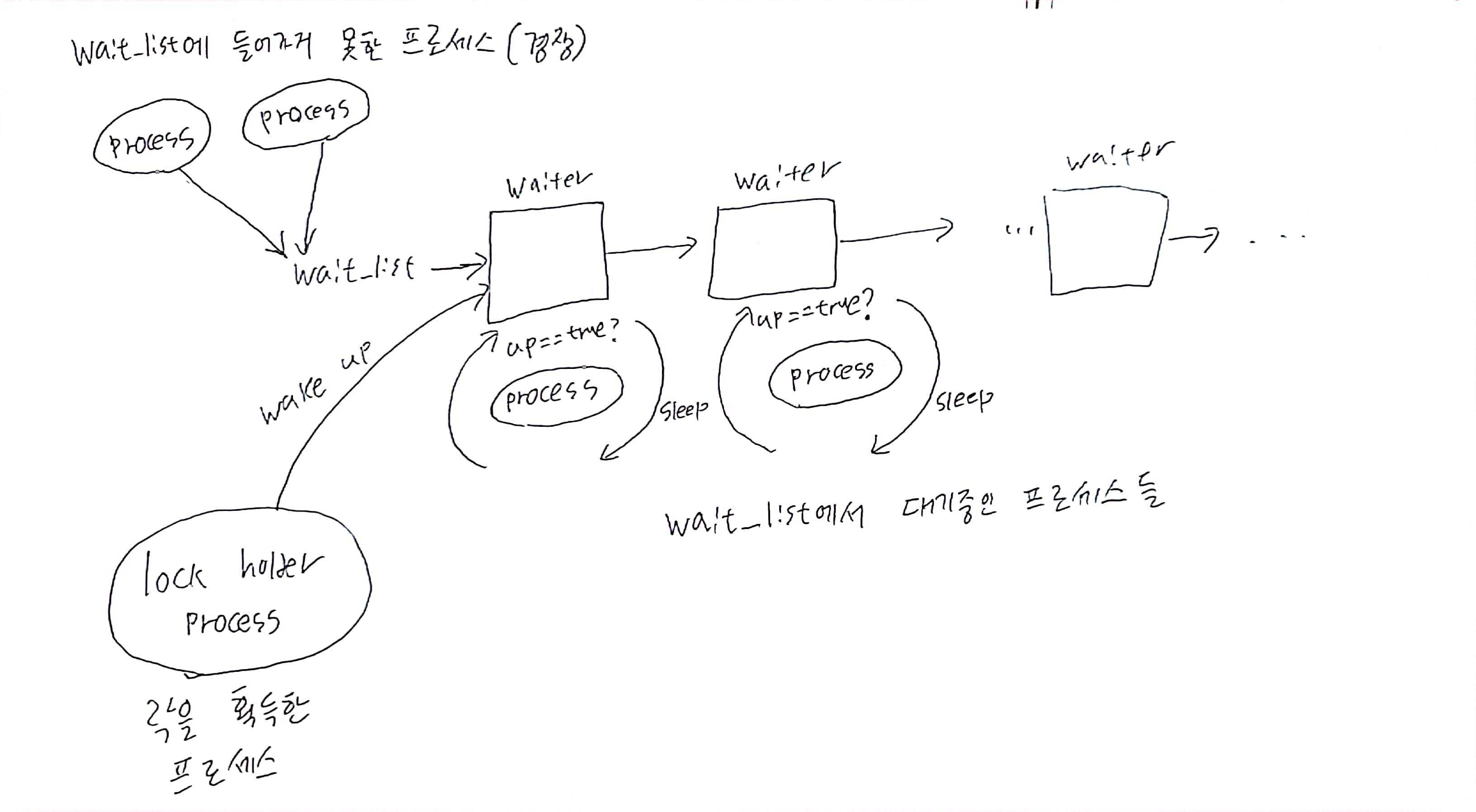semaphore의 매커니즘을 분석해보자. 아래 그림은 코드를 그림으로 옮긴 것이다.

struct semaphore
이전 글에서 살펴본 semaphore 구조체다. 구조체 자체를 보호하기 위한 lock, lock을 획득할 수 있는 스레드 수를 나타내는 count, 대기중인 스레드를 나타내는 wait_list가 있다.
/* Please don't access any members of this structure directly */
struct semaphore {
raw_spinlock_t lock;
unsigned int count;
struct list_head wait_list;
};struct semaphore_waiter
semaphore 대기를 하기 위해 사용되는 자료구조이다. 매우 직관적이다. list는 list의 시작 노드를, task는 대기중인 프로세스를, up은 해당 프로세스가 락을 획득했는지를 나타낸다. semaphore_waiter 구조체도 락이 필요할거라고 생각했는데, 코드를 잘 분석해보면 semaphore의 spinlock으로 관리된다는걸 알 수 있다.
/* Functions for the contended case */
struct semaphore_waiter {
struct list_head list;
struct task_struct *task;
bool up;
};down_interruptible 분석
down은 변종이 너무 많으니, 그중 하나인 down_interruptible을 분석해보자. 어차피 모두 내부적으로는 __down_common을 호출하므로 거기서 거기이다.
/**
* down_interruptible - acquire the semaphore unless interrupted
* @sem: the semaphore to be acquired
*
* Attempts to acquire the semaphore. If no more tasks are allowed to
* acquire the semaphore, calling this function will put the task to sleep.
* If the sleep is interrupted by a signal, this function will return -EINTR.
* If the semaphore is successfully acquired, this function returns 0.
*/
int down_interruptible(struct semaphore *sem)
{
unsigned long flags;
int result = 0;
raw_spin_lock_irqsave(&sem->lock, flags);
if (likely(sem->count > 0))
sem->count--;
else
result = __down_interruptible(sem);
raw_spin_unlock_irqrestore(&sem->lock, flags);
return result;
}
EXPORT_SYMBOL(down_interruptible);down_interruptible은 먼저 인터럽트를 비활성화한다. 그 후 sem->count > 0인 경우, 락을 획득할 수 있다는 것이므로 획득한 후, sem->lock을 반환한다. 만약 sem->count <= 0이어서 획득할 수 없는 경우에는 __down_interruptible를 호출한다.
__down_interruptible
static noinline int __sched __down_interruptible(struct semaphore *sem)
{
return __down_common(sem, TASK_INTERRUPTIBLE, MAX_SCHEDULE_TIMEOUT);
}
/*
* Because this function is inlined, the 'state' parameter will be
* constant, and thus optimised away by the compiler. Likewise the
* 'timeout' parameter for the cases without timeouts.
*/
static inline int __sched __down_common(struct semaphore *sem, long state,
long timeout)
{
struct semaphore_waiter waiter;
list_add_tail(&waiter.list, &sem->wait_list);
waiter.task = current;
waiter.up = false;
for (;;) {
if (signal_pending_state(state, current))
goto interrupted;
if (unlikely(timeout <= 0))
goto timed_out;
__set_current_state(state);
raw_spin_unlock_irq(&sem->lock);
timeout = schedule_timeout(timeout);
raw_spin_lock_irq(&sem->lock);
if (waiter.up)
return 0;
}
timed_out:
list_del(&waiter.list);
return -ETIME;
interrupted:
list_del(&waiter.list);
return -EINTR;
}__down_interruptible은 내부적으로 __down_common을 호출한다. __down_common은 semaphore 구조체, state (TASK_INTERRUPTIBLE, TASK_UNINTERRUPTIBLE 등 프로세스의 state), 그리고 timeout을 파라미터로 받는다. down_interruptible은 프로세스가 중간에 시그널을 받도록 하므로, state = TASK_INTERRUPTIBLE로 호출한다.
함수의 초반부에서는 sem->wait_list에 현재 프로세스를 넣어서 대기하도록 한다.
그 후에는 무한루프를 돌면서 다음의 작업을 반복한다.
1. 시그널을 받았거나 timeout이 되면 리스트를 제거하고 리턴
2. schedule_timeout으로 sleep한다.
3. 깨어난다. 락을 획득했는가? 획득했다면 탈출한다. 아니면 다시 1번부터 반복
up 분석
up도 구현이 매우 간단하다. wait_list가 비어있는 경우에는 count를 그냥 증가시키고, 비어있지 않은 경우에는 sem->wait_list에서 가장 첫 번째 노드를 가져온다. 그 후 대기중인 프로세스의 waiter.up = true로 변경하고, wake_up_process로 깨운다.
/**
* up - release the semaphore
* @sem: the semaphore to release
*
* Release the semaphore. Unlike mutexes, up() may be called from any
* context and even by tasks which have never called down().
*/
void up(struct semaphore *sem)
{
unsigned long flags;
raw_spin_lock_irqsave(&sem->lock, flags);
if (likely(list_empty(&sem->wait_list)))
sem->count++;
else
__up(sem);
raw_spin_unlock_irqrestore(&sem->lock, flags);
}
EXPORT_SYMBOL(up);
static noinline void __sched __up(struct semaphore *sem)
{
struct semaphore_waiter *waiter = list_first_entry(&sem->wait_list,
struct semaphore_waiter, list);
list_del(&waiter->list);
waiter->up = true;
wake_up_process(waiter->task);
}semaphore는 공정한가?
wait_list에 진입한 후에는 먼저 들어온 순서대로 깨어나므로 공정하다. 하지만 wait_list에 진입하는 과정 자체는 spinlock 매커니즘에 따라서 공정하지 않을 수 있다.
'Kernel > Locking Primitives' 카테고리의 다른 글
| [Linux Kernel] RCU (Read-Copy-Update) (1) | 2021.11.05 |
|---|---|
| [Linux Kernel] semaphore (1) - semaphore의 개념과 사용법 (1) | 2021.04.22 |
| [kernel/locking] spinlock (2) - Test And Set, Ticket, ABQL, MCS (0) | 2021.03.28 |
| [kernel/locking] spinlock (1) - spinlock 사용법 (5) | 2021.03.27 |
| 락 (lock)이란 무엇인가 (3) | 2021.03.16 |

댓글